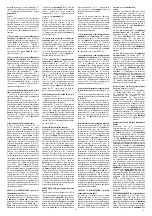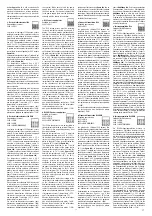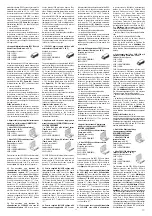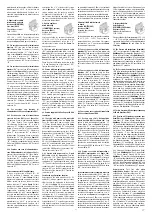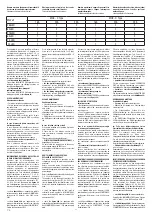
15
Per il collegamento alla linea DMX occorre
montare i connettori presenti nel sacchetto sui
cavi di collegamento (non forniti da FAEL) tra
gli apparecchi eseguendo una saldatura come
indicato in
figura 45
. Per la protezione dei cavi
DMX è opportuno inserire tali cavi in apposite
tubazioni di protezione separate dal cavo di
potenza. Utilizzare un cavo DMX ad impedenza
costante a 2 poli interni schermati, specifico per
la connessione di apparecchiature che utilizzano
il protocollo DMX512 con impedenza nominale di
120 Ohm. Scegliere un cavo con guaina esterna
consona alle temperature ambientali della zona
di installazione.
Parte comune per tutti i capitoli sopra
In base al pressacavo utilizzato (G1, G2
e/o G3): verificare il serraggio, con chiave
inglese, del corpo “X” (vedere
figura
13
) del/i
pressacavo/i applicando un momento torcente
di 4Nm; serrare con cura e a fondo, con chiave
inglese, la ghiera “Y” (vedere
figura
13
) del/i
pressacavo/i applicando un momento torcente
di 3.5Nm. Una volta collegato elettricamente
l’apparecchio, richiudere il coperchio della
cassetta di derivazione serrando le 4 viti V” in
acciaio inox (vedere
figura
1b
) applicando un
momento torcente di 5.2Nm assicurandosi che
la guarnizione sia perfettamente nella sua sede.
Verificare che il coperchio sia perfettamente in
battuta sulla cassetta di derivazione.
CONNESSIONE CONNETTORI
Per versione external driver (vedere
figura1b
)
l’ apparecchio viene fornito con i connettori
maschi non connessi ai connettori femmina
presenti sul corpo. Solo una volta ultimato il
montaggio e l’ installazione dell’ apparecchio
sui supporti (strutture metalliche o traversa)
connettere i connettori maschi ad innesto rapido
con i connettori femmina presenti sul corpo,
prestando attenzione a non danneggiarli (vedere
figura
46
).
• Inserire il connettore maschio montato sul
cavo riportante lettera di riferimento “a” con il
connettore femmina montato sul corpo avente
stessa lettera di riferimento
“A”
.
• Tramite l’ ausilio di chiave inglese “C1”
mantenere fisso in posizione il corpo del
connettore
“A”
montato sul corpo e serrarne a
fondo la ghiera mediante la chiave inglese “C2”.
• Ripetere la procedura per tutti i connettori
presenti
Per la corretta sequenza di connessione , rifarsi
allo schema (vedere
figura
46
).
2.
Apparecchio con gruppo
di alimentazione separato
con cassetta di derivazione
on board
versione SIMMETRICA
Versione disponibile per temperatura ambiente
50°C (-30 ÷ +50°C).
a. Piastra di alimentazione IP20
b. Piastra di alimentazione IP20 DMX
c. Piastra di alimentazione IP66
d. Gruppo di alimentazione box FAEL IP66
driver interni
e. Gruppo di alimentazione box FAEL IP66
driver esterni
Per il collegamento tra il proiettore ed il gruppo di
alimentazione separato è possibile utilizzare cavi
tipo FG16R16 o tipo FG16M16 per temperatura
ambiente compresa tra -15°C e +50°C (vedere
paragrafo 2.1
); in alternativa è possibile
utilizzare cavi similari conformi alle normative
nazionali ed internazionali scelti a seconda
della temperatura ambiente di installazione.
Cavo adatto per posa fissa o mobile, per
ambienti interni ed esterni e tecnologia per
lo spettacolo. Cavo di tipo autoestinguente,
resistente ai raggi UV. Per il collegamento tra il
proiettore ed il gruppo di alimentazione separato
è possibile utilizzare cavi tipo ÖLFLEX CLASSIC
110 black 0,6/1kV per temperatura ambiente
compresa tra -30°C e +50°C (vedere
paragrafo
2.1
); in alternativa è possibile utilizzare cavi
similari conformi alle normative nazionali ed
internazionali scelti a seconda della temperatura
ambiente di installazione. Cavo adatto per
posa fissa o mobile, per ambienti interni ed
esterni e tecnologia per lo spettacolo. Cavo di
tipo autoestinguente, resistente ai raggi UV.
Utilizzare cavo multipolare 10 conduttori (vedere
paragrafo 2.1
); oppure utilizzare, più facilmente
male “W” (male connector_OUT) and female
“K” (female connector_IN) connectors already
mounted, available at the appliance output,
meant for the connection of the DMX cable;
other two XLR type male and female connectors
are supplied in a bag. For the connection to the
DMX line, fit on the connection cables (not
supplied by FAEL), between appliances, the
connectors supplied in the bag and seal as
shown in
figure 45
. To protect the DMX cables
it is recommended to have them inserted in
special protection pipes separated from the
power cable. Use a 2 inner shielded poles DMX
cable having constant impedance specific for
the connection of the appliances that require
DMX512 protocol with 120 Ohms nominal
impedance. Use a cable with outer sheath
suitable to the environmental temperatures of
the installation area.
Part shared by all previous chapters
Depending on the cable gland used (G1, G2
and/or G3): using a spanner, apply a torque
4Nm to check the tightening of the housing
“X” (check the
figure
13
); use a spanner and
apply a torque of 3.5Nm to tighten carefully and
completely the ring nut “Y” (check the
figure
13
). Once the appliance is connected, close
back the cables box cover and tighten the 4
“V” stainless steel screws (check
figure 1b
) by
applying 5.2Nm torque, making sure the gasket
is perfectly fit. Ensure the cover is perfectly
abutted to the cables box.
CONNECTING THE CONNECTORS
The external driver versions (check
figure1b
)
are supplied with the male connectors
detached from the female connectors installed
on the luminaire. Connect the quick connect
male connectors to the female connectors
installed on the luminaire, being careful not
to damage them (check
figure
46
), only after
assembling and installing the luminaire on the
mounts (metal frames or beam).
• Insert the male connector fitted on the cable
marked with “a” in the corresponding female
connector installed on the luminaire (also
marked with
“A”
).
• Use the spanner, “C1”, to keep the body of
the
“A”
connector installed on the luminaire
in place while tightening the ring nut using
spanner “C2”.
• Repeat these steps on all the connectors
installed on the luminaire For the correct
connection sequence, please refer to the
diagram (check
figure 46
).
2. Projector with separated
power supply unit with
built-in cables box
SYMMETRICAL version
Version available for ambient temperature 50°C
(-30 ÷ +50°C).
a. IP20 power supply plate
b. IP20 DMX power supply plate
c. IP66 power supply plate
d. IP66 FAEL power supply unit box,
internal drivers
e. IP66 FAEL power supply unit box,
external drivers
The floodlight can be connected to the
separate power supply unit using FG16R16 or
FG16M16 cables that are suitable for ambient
temperatures ranging from -15°C to +50°C
(see
paragraph 2.1
); alternatively, similar
cables, suitable for the ambient temperature
at the place of installation and made in
compliance with applicable national and
international regulations, can be used. Cable
suitable for fixed or mobile installation, indoor
and outdoor use and entertainment technology.
Self-extinguishing, UV-resistant cable. The
floodlight can be connected to the separate
power supply unit using ÖLFLEX CLASSIC
110 black 0.6/1kV cables that are suitable
for ambient temperatures ranging from -30°C
to +50°C (see
paragraph 2.1
); alternatively,
similar cables, suitable for the ambient
temperature at the place of installation and
made in compliance with applicable national
and international regulations, can be used.
Cable suitable for fixed or mobile installation,
indoor and outdoor use and entertainment
technology. Self-extinguishing, UV-resistant
cable. Use a multi-conductor cable with 10
monter les connecteurs présents dans le sachet
des câbles de branchement (non fournis par FAEL)
entre les appareils, puis souder comme l’indique
la
figure 45
. Pour protéger les câbles DMX, il
convient de les insérer dans des tuyauteries
de protection séparées du câble de puissance.
Utiliser un câble DMX à impédance constante à 2
pôles internes blindés, spécifique pour connecter
les appareillages utilisant le protocole DMX512
avec impédance nominale de 120 Ohm. Choisir
un câble muni de gaine externe adaptée aux
températures ambiantes de la zone d’installation.
Partie commune à tous les chapitres
ci-dessus
Selon le presse-câbles utilisé (G1, G2 et/ou G3):
Vérifier le serrage du corps “X” (voir
figure
13
)
du/des serre-câbles avec une clé anglaise,
en appliquant un moment de torsion de 4Nm.
Toujours avec la clé anglaise, serrer bien à fond
le collier de serrage “Y” (voir
figure
13
) du/
des serre-câbles en appliquant un moment de
torsion de 3.5Nm. Une fois l’appareil branché
électriquement, refermer le couvercle de la
boite de dérivation en serrant les 4 vis V” en
acier inox (voir
figure 1b
) en appliquant un
moment de torsion de 5.2Nm tout en contrôlant
que la garniture loge parfaitement dans son
emplacement. Vérifier que le couvercle est
parfaitement en butée sur la boite de dérivation.
CONNEXION CONNECTEURS
Pour la version external driver (voir
figure1b
)
l’appareil est fourni avec les connecteurs mâles
non connectés aux connecteurs femelles présents
sur le corps. Ce n’est qu’après avoir terminé le
montage et installé l’appareil sur les supports
(structures métalliques ou traverse) qu’il est
possible de connecter les connecteurs mâles à
enclenchement rapide aux connecteurs femelles
présents sur le corps, en veillant à ne pas les
endommager (voir
figure
46
).
• Introduire le connecteur mâle monté sur le
câble référence “a” au connecteur femelle monté
sur le corps avec la même lettre de référence
“A”
.
• À l’aide d’une clé anglaise “C1”, maintenir fixe
en position le corps du connecteur
“A”
monté sur
le corps et serrer la bague toujours à l’aide de la
clé anglaise “C2”.
• Répéter la procédure pour tous les connecteurs
présents
Pour la séquence de connecteurs présents, se
référer au schéma (voir
figure
46
).
2. Appareil avec groupe
d’alimentation séparé
et boite de dérivation on board
version SYMÉTRIQUE
Version disponible pour température ambiante de
50°C (-30 ÷ +50°C).
a. Plaque d’alimentation IP20
b. Plaque d’alimentation IP20 DMX
c. Plaque d’alimentation IP66
d. Groupe d’alimentation box FAEL IP66
drivers internes
e. Groupe d’alimentation box FAEL IP66
drivers externes
Pour brancher le projecteur et le groupe
d’alimentation séparé, il est possible d’utiliser
des câbles de type FG16R16, ou de type
FG16M16 pour température ambiante comprise
entre -15°C et +50°C (voir
paragraphe 2.1
); en
alternative, il est possible d’utiliser des câbles
similaires, conformes aux réglementations
nationales et internationales, à choisir en fonction
de la température ambiante du lieu d’installation.
Câble adapté pour pose fixe ou mobile, pour
environnements intérieurs et extérieurs et
technologie pour le spectacle. Câble de type auto-
extinguible, résistant aux rayons UV. Pour brancher
le projecteur et le groupe d’alimentation séparé, il
est possible d’utiliser des câbles de type ÖLFLEX
CLASSIC 110 black 0,6/1kV pour température
ambiante comprise entre -30°C et +50°C (voir
paragraphe 2.1
); en alternative, il est possible
d’utiliser des câbles similaires, conformes aux
réglementations nationales et internationales, à
choisir en fonction de la température ambiante
du lieu d’installation. Câble adapté pour pose
fixe ou mobile, pour environnements intérieurs et
extérieurs et technologie pour le spectacle. Câble
de type auto-extinguible, résistant aux rayons UV.
Utiliser un câble multipolaire à 10 conducteurs
(voir
paragraphe 2.1
) ou bien utiliser un câble
multipolaire à 12 conducteurs (11 conducteurs
Buchsen vom Typ XLR werden in einem Beutel
geliefert. Um eine Verbindung mit der DMX-
Leitung herzustellen, müssen die Verbinder
im Beutel an den Verbindungskabeln (nicht
von FAEL geliefert) zwischen den Geräten
durch Schweißen angebracht werden, wie in
Abbildung 45
gezeigt. Zum Schutz von DMX-
Kabeln empfiehlt es sich, diese Kabel in vom
Stromkabel getrennten Schutzrohren zu verlegen.
Verwenden Sie ein DMX-Kabel mit konstanter
Impedanz mit 2 abgeschirmten internen Polen,
speziell für den Anschluss von Geräten mit dem
DMX512-Protokoll mit einer Nennimpedanz
von 120 Ohm. Wählen Sie ein Kabel mit einem
Außenmantel, der den Umgebungstemperaturen
des Installationsbereichs entspricht.
Gemeinsamer Teil für alle oben aufgeführten
Kapitel
Basierend auf der verwendeten
Kabeldurchführung (G1, G2 und/oder G3):
Überprüfen Sie, mit einem Drehmomentschlüssel,
den Anzug des Gehäuses “X” (siehe
Abbildung
13
) der Kabeldurchführung/en mit einem
Drehmoment von 4Nm. Ziehen Sie die Schraube
“Y” (siehe
Abbildung
13
) der Kabeldurchführung/
en mit Drehmoment 3.5Nm vorsichtig an. Wenn
das Gerät elektrisch angeschlossen ist, die
Abdeckung des Verteilerkastens wieder schließen
indem die 4 Schrauben “V” aus Edelstahl (siehe
Abbildung
1b
) mit einem Drehmoment von 5,2
Nm angezogen werden, um sicherzustellen, dass
die Dichtung perfekt sitzt. Stellen Sie sicher, dass
die Abdeckung perfekt am Verteilerkasten anliegt.
ANSCHLUSS DER VERBINDER
Für die Version mit externem Treiber (siehe
Abbildung 1b
) wird das Gerät mit Steckern
geliefert, die nicht an den Buchsen auf dem
Gehäuse angeschlossen sind. Erst nach Abschluss
der Montage und Installation des Geräts auf den
Halterungen (Metallstrukturen oder Querträger)
die Schnellanschluss-Stecker mit den Buchsen
am Gehäuse verbinden und darauf achten, diese
nicht zu beschädigen (siehe
Abbildung
46
).
• Den Stecker, der am Kabel montiert ist mit
dem Referenzbuchstaben “a” einsetzen mit
der Buchse, die am Gehäuse mit dem gleichen
Referenzbuchstaben
“A”
montiert ist.
• Mit dem Drehmomentschlüssel “C1” das
Gehäuse des Verbinders
“A”
, der am Gehäuse
montiert ist, fest in Position halten und den
Ring mit dem Drehmomentschlüssel “C2“ ganz
anziehen.
• Den Vorgang für alle vorhandenen Verbinder
wiederholen
Für die richtige Verbinungsreihenfolge, auf das
Diagramm Bezug nehmen (siehe
Abbildung
46
).
2. Gerät mit getrennter
Versorgungseinheit
mit On-Board Verteilerkasten
SYMMETRISCHE Version
Version verfügbar für Raumtemperatur 50°C
(-30 ÷ +50°C).
a. Versorgungsplatte IP20
b. Versorgungsplatte IP20 DMX
c. Versorgungsplatte IP66
d. Versorgungsplatte Box FAEL IP66
interne Treiber
e. Versorgungsplatte Box FAEL IP66
externe Treibe
r
Für den Anschluss zwischen Scheinwerfer
und getrennter Versorgungseinheit können
Kabel vom Typ FG16R16, oder FG16M16
verwendet werden für Umgebungstemperaturen
zwischen -15°C und +50°C (siehe
Abschnitt
2.1
); Alternativ können ähnliche Kabel
verwendet werden, die mit den nationalen und
internationalen Standards übereinstimmen,
die je nach Installationsumgebung ausgewählt
wurden. Kabel für die feste oder abnehmbare
Installation, für Innen- und Außenbereiche und
Veranstaltungstechnik. Selbstverlöschendes
Kabel, UV-beständig. Für den Anschluss zwischen
Scheinwerfer und getrennter Versorgungseinheit
können Kabel vom Typ ÖLFLEX CLASSIC
110 black 0,6/1kV verwendet werden für
Umgebungstemperaturen zwischen -30°C
und +50°C (siehe
Abschnitt 2.1
); Alternativ
können ähnliche Kabel verwendet werden,
die mit den nationalen und internationalen
Standards übereinstimmen, die je nach
Installationsumgebung ausgewählt wurden.
Kabel für die feste oder abnehmbare
Installation, für Innen- und Außenbereiche und
Veranstaltungstechnik. Selbstverlöschendes
Kabel, UV-beständig. Ein mehrpoliges Kabel mit
10 Leitern verwenden (siehe
Abschnitt 2.1
).
oder das auf dem Markt leichter erhältliche
mehrpolige Kabel mit 12 Leitern (11 schwarze
Leiter nummeriert von 1 bis 11 + 1 gelb-grüner
18
Содержание 514084501
Страница 1: ...Glamox O92 O93 SYM User manual ...
Страница 6: ...3 3 6 ...
Страница 7: ...4 7 ...
Страница 11: ...8 11 ...
Страница 12: ...9 12 ...
Страница 15: ...12 15 ...
Страница 17: ...14 17 ...
Страница 20: ...17 20 ...
Страница 24: ...21 24 ...
Страница 26: ...23 26 ...
Страница 29: ...26 29 ...
Страница 30: ...27 30 ...
Страница 32: ...29 32 ...
Страница 33: ...30 33 ...
Страница 34: ...31 34 ...
Страница 35: ...35 ...
Страница 36: ...36 ...
Страница 37: ...34 37 ...
Страница 39: ...35 Note 39 ...
















